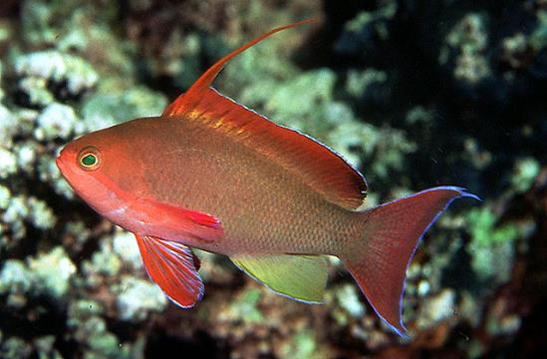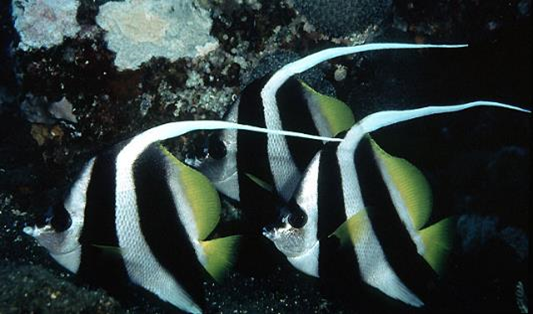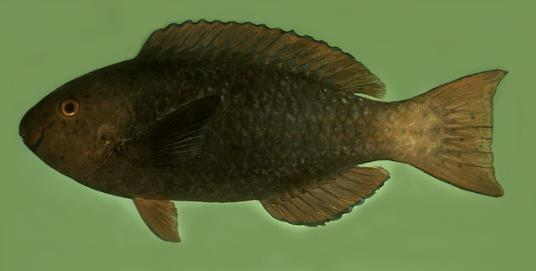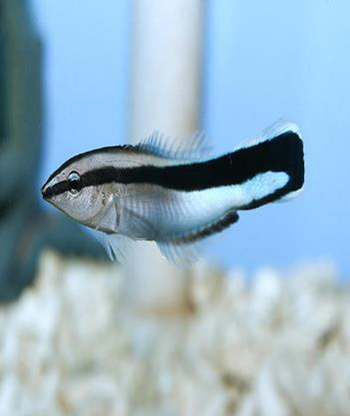Entry Zone
NAME : Sea Goldie
NAME OF THE SPECIE: Sea Goldie
LOCATION : Pseudanthias squamipinnis is widespread in the Indo-West Pacific, occurring in the Red Sea south to South Africa (including Socotra, the Seychelles, Comoros, Mayotte, Reunion, Mauritius, Madagascar and Europa Island) east to Niue, north to central Japan and Jeju-do Island and south to New South Wales, Australia.
HABITAT: Pseudanthias squamipinnis occurs above coral outcrops, patch reefs of clear lagoons, channels, our outer reef slopes in large aggregations. This species is territorial and tends to stay within 20 m of their home rock or coral outcrop.
HABITAT (15-20 words): Inhabit coral outcrops, patch reefs of clear lagoons, channels, our outer slopes in large aggregations.
WEIGHT: upto 15 cm. ; upto 0.01 KG.
DIET: Not Details
FOOD: This species is a pelagic spawner and feeds on zooplankton
FOOD & DIET: They are pelagic spawners and feed on zooplankton.
FACT: The midas blenny, Ecsenius midas, goes through a phase of yellow colouration and is a social mimic of the sea goldie. Females are induced to change sex by removal of males from social group.
NAME : Blue Devil Damsel
NAME OF THE SPECIE: Blue Devil Damsel
LOCATION : They are found throughout the Indo-West Pacific region; the eastern edge of the Indian Ocean, Western Australia to New Guinea on the northern portion of the Great Barrier Reef, Solomon, Mariana, and Caroline Islands, Indonesia, Philippines, Taiwan and Ryukyu Islands. They are also reported from Vanuatu and New Caledonia; Palau and Yap in Micronesia.
HABITAT: The Blue Damselfish inhabits clear sheltered lagoons, protected inshore reefs, and subtidal reef flats. They occur at depths between 1 to 33 feet.
HABITAT (15-20 words): inhabit clear sheltered lagoons, protected inshore reefs and subtidal reef flats.
WEIGHT: upto 8.5 cm. ; upto 0.01 KG.
DIET: Not Details
FOOD: The Blue Damselfish are omnivores. In the wild they feed on filamentous algae along with tiny crustaceans, such as planktonic copepods and amphipods, and planktonic fish eggs. shrimp, vitamin-enriched brine shrimp, cyclops.
FOOD & DIET: Feed on filamentous algae along with tiny crustaceans.
FACT: This species is dichromatic, with distinct color differences between the adult male and female.
NAME : Emperor Angelfish
NAME OF THE SPECIE: Emperor Angelfish
LOCATION : This species is widespread throughout the Indian Ocean and the western and central Pacific Ocean. It ranges from coastal East Africa and the Red Sea in the west to the Tuamotu Islands (French Polynesia), Line Islands (Kiribati and USA). It is a vagrant in the Hawaiian Islands (USA). Populations have been recorded as far north as southern Japan (including the Ogasawara Islands [=Bonin Islands] and Izu Islands) to the Great Barrier Reef (Australia), New Caledonia (France) and the Austral Islands (French Polynesia) in the south.
HABITAT: This species inhabits a wide variety of habitats with individuals usually reported from coastal and outer reefs, deep lagoons, often in areas of rich coral growth. It is commonly seen near ledges and caves. The juveniles usually occur under ledges or in holes on shallow reefs.
HABITAT (15-20 words): inhabit coastan and outer reefs, deep lagoons in areas of rich coral growth.
WEIGHT: upto 40 cm. ; upto 1 KG
DIET: Not Details
FOOD: Emperor Angelfish are omnivores, in the wild they eat a wide variety of sponges and encrusting organisms along with small amounts of algae, tunicates, hydroids, and bryozoans.
FOOD & DIET: Feed on a variety of sponges and encrusting organisms.
FACT: It is one of the most favorite of photographers, artists, and aquarists because of its unique, brilliant pattern of coloration.
NAME : Longfin Banner Fish
NAME OF THE SPECIE: Longfin Banner Fish
LOCATION : This species is widely distributed throughout much of the tropical Indo-Pacific region. It ranges from the East African coast and the Arabian Gulf in the west to the Society Islands (French Polynesia) in the east, and from southern Japan and the island of Taiwan in the north to Lord Howe Island (Australia) in the south.
HABITAT: This species is associated with coral and rocky reefs, and is often found in deep lagoon areas and outer reef slopes, although animals may inhabit shallower water in protected reef areas.
HABITAT (15-20 words): Inhabit deep lagoons areas and outer reef slopes.
WEIGHT: upto 25 cm. ; upto 0.06 KG.
DIET: Not Details
FOOD: The Black and White Heniochus are omnivores. In the wild these fish are planktivores but will also eat benthic invertebrates. Eat parasites off of other fish, live brine, worms.
FOOD & DIET: Feed on bentic invertebrates, parasites, live brine and worms.
FACT: Its body is compressed laterally, the first rays of its dorsal fin stretch in a long white filament.
NAME : Singapore Parrot Fish
NAME OF THE SPECIE: Singapore Parrot Fish
LOCATION : Scarus prasiognathos is distributed eastwards from the Maldive Islands through Indonesia to New Ireland in Papua New Guinea, and north to the Ryukyu Islands, including Palau and Micronesia.
HABITAT: Scarus prasiognathos is associated with the outer slope of coral reefs but will enter shallow water in protected areas such as lagoons.
HABITAT (15-20 words): Inhabit outer slopes of coral reefs.
WEIGHT: upto 70 CM. ; upto 0.1 KG. weight will be checked and reverted by committee members
DIET: Not Details
FOOD: grazes on benthic algae
FOOD & DIET: Feed on benthic algae
FACT: These are oviparous in nature and have distinct pairing nature during breeding season.
NAME : Cleaner Wrasse
NAME OF THE SPECIE: Cleaner Wrasse
LOCATION : This species is found in the Indo-Pacific from southern and eastern Africa and the Red Sea to the Tuamotus in the south Pacific, and from southern Japan to the southern Great Barrier Reef and south-western Australia.
HABITAT: This species inhabits coral rich areas and subtidal reef flats to seaward reefs to depths of at least 40 m.
HABITAT (15-20 words): Inhabit coral rich areas and subtidal reef flats.
WEIGHT: upto 13.97 cm upto 0.01 KG.
DIET: Not Details
FOOD: The Bluestreak Cleaner Wrasses are carnivorous. They obtain all or virtually all of their nutrition by consuming parasites dead tissues, mucus, and other debris from the bodies, fins, and mouths of other fish.
FOOD & DIET: Feed on parasites, dead tissues, mucus and other debris.
FACT: Cleaner Wrasses are peaceful attractive fish with a most intriguing "dance" that they perform to solicit clients (other fish) and to calm them, allowing the cleaners to remove parasites and other debris from their clients bodies, fins, and mouths.
વૈજ્ઞાનિક નામ : Pseudanthias squamipinnis
જાતિનું નામ: Sea Goldie
સ્થાન: વિગતો નથી
લંબાઈ અને વજન: વિગતો નથી
ખોરાક (વૈકલ્પિક) આહાર : તેઓ સમુદ્રમાં ઈંડા આપનારી પ્રજાતિમાંની એક છે. અને ઝુપ્લેંક્ટોન જેવા સૂક્ષ્મ જંતુઓ અને સેંદ્રિય પદાર્થ ખાય છે.
વિશેષતા: અન્ય એન્થિયાઓની જેમ, સમુદ્ર ગોલ્ડી એ પ્રોટોગાયનસ હર્મેફ્રોડાઇટ છે; નર પાંચથી 10 માદાઓનું હેરમ જાળવી રાખે છે, પરંતુ જ્યારે નર મૃત્યુ પામે છે, ત્યારે માદા માંથી એક લૈંગિક પરીવર્તન કરી ગુમ થયેલ નર ની જગ્યા લઈલે છે.
વૈજ્ઞાનિક નામ : Chrysiptera cyanea
જાતિનું નામ: Blue Devil Damsel
સ્થાન: વિગતો નથી
લંબાઈ અને વજન: વિગતો નથી
ખોરાક (વૈકલ્પિક) આહાર : તંતુ વાળી શેવાળની સાથે સૂક્ષ્મ ક્રસ્ટેશિયન્સ ખાય છે.
વિશેષતા: આ પ્રજાતિ દ્વિરંગી છે જેમાં પુખ્તવયના નર અને માદાના રંગો સ્પષ્ટ રીતે જુદા હોય છે.
વૈજ્ઞાનિક નામ : Pomacanthus imperator
જાતિનું નામ: Emperor Angelfish
સ્થાન: વિગતો નથી
લંબાઈ અને વજન: વિગતો નથી
ખોરાક (વૈકલ્પિક) આહાર : વિવિધ પ્રકારના વાદળી અને પોપડા થી ઢંકાયેલા પ્રાણી ખાય છે.
વિશેષતા: પોતાની વિશિષ્ટ, તેજસ્વી રંગીન ભાતને કારણે તેઓ ચિત્રકારો,કલાકારો અને એક્વેરિસ્ટ માં લોકપ્રિય છે.
વૈજ્ઞાનિક નામ : Heniochus acuminatus
જાતિનું નામ: Longfin Banner Fish
સ્થાન: વિગતો નથી
લંબાઈ અને વજન: વિગતો નથી
ખોરાક (વૈકલ્પિક) આહાર : તળિયાના કરોડરજ્જુ વિનાના પ્રાણીઓ,પરોપજીવીઓ, જીવંત ઝીંગા, અને કીડાઓ ખાય છે.
વિશેષતા: લોગફીન બેનરફિશનું શરીર બન્ને પડખેથી ચપટું થયેલ હોય છે. અને તેના પીઠના પાછળના મીનપંખોની પહેલી હરોળ સફેદ રંગના તંતુ જેવી ખેંચાયેલ હોય છે.
વૈજ્ઞાનિક નામ : Scarus prasiognathos
જાતિનું નામ: Singapore Parrot Fish
સ્થાન: વિગતો નથી
લંબાઈ અને વજન: વિગતો નથી
ખોરાક (વૈકલ્પિક) આહાર : તળિયા ઉપર રહેલી શેવાળને ખાય છે.
વિશેષતા: સિંગાપુર પેરેટફિશ ઈંડા મુકતી માછલી છે અને સંવનન કાળ દરમિયાન સ્વભાવગત્ અલાયદી જોડી બનાવે છે.
વૈજ્ઞાનિક નામ : Labroides dimidiatus
જાતિનું નામ: Cleaner Wrasse
સ્થાન: વિગતો નથી
લંબાઈ અને વજન: વિગતો નથી
ખોરાક (વૈકલ્પિક) આહાર : પરોપજીવીઓ,મૃતપેશીઓ, લાળ અને બીજો અન્ય કચરો ખાય છે.
વિશેષતા: ક્લીનર રેસ (Cleaner Wrasse) શાંત અને આકર્ષક માછલી છે.તે બીજી માછલીઓને આકર્ષવા માટે નૃત્ય કરે છે.
वैज्ञानिक नाम : Pseudanthias squamipinnis
जाति का नाम : Sea Goldie
जगह: कोई विवरण नहीं
लंबाई और वजन: कोई विवरण नहीं
खाना: कोई विवरण नहीं
भोजन (वैकल्पिक) आहार: ये महासागरीय समांडक है जो मुख्य्तः प्राणी प्लवक खाती है।
विशेषता: अन्य एंथियस की तरह, समुद्री गोल्डी एक प्रोटोजीनस हेर्मैफ्रोडाइट है; एक नर पांच से १० मादाओं का एक झुंड रखता है, लेकिन जब नर की मृत्यु हो जाती है, तो मादाओं में से एक लींग परीवर्तन करके लापता नर की जगह ले लेती है।
वैज्ञानिक नाम : Chrysiptera cyanea
जाति का नाम : Blue Devil Damsel
जगह: कोई विवरण नहीं
लंबाई और वजन: कोई विवरण नहीं
खाना: कोई विवरण नहीं
भोजन (वैकल्पिक) आहार: नन्हें परुषकवचियों के साथ-साथ रेशेदार शैवाल भी खाना पसंद करती हैं।
विशेषता: यह प्रजाति डायक्रोमैटिक है, इसलिए नर और मादा के बीच रंगों की कई तरह की भिन्नता होती है।
वैज्ञानिक नाम : Pomacanthus imperator
जाति का नाम : Emperor Angelfish
जगह: कोई विवरण नहीं
लंबाई और वजन: कोई विवरण नहीं
खाना: कोई विवरण नहीं
भोजन (वैकल्पिक) आहार: ये कई तरह के स्पंज और पपड़ीदार जीवों को खाना पसंद करती हैं।
विशेषता: रंगों के अपने विशिष्ट और मेधावी पैटर्न के कारण ये छायाकारों, चित्रकारों और जलविदों के बीच बहुत लोकप्रिय हैं।
वैज्ञानिक नाम : Heniochus acuminatus
जाति का नाम : Longfin Banner Fish
जगह: कोई विवरण नहीं
लंबाई और वजन: कोई विवरण नहीं
खाना: कोई विवरण नहीं
भोजन (वैकल्पिक) आहार: नितलस्थ अकशेरुकीय प्राणी, परजीवी, जीवित झींगे और कीड़े खाती हैं।
विशेषता: लॉङ्गफिन बैनरफिश का शरीर पीछे की तरफ चिपटा होता है। इसके पिछले शल्कों की पहली पंक्ति एक लंबे सफेद फिलामेंट में खिंची होती है।
वैज्ञानिक नाम : Scarus prasiognathos
जाति का नाम : Singapore Parrot Fish
जगह: कोई विवरण नहीं
लंबाई और वजन: कोई विवरण नहीं
खाना: कोई विवरण नहीं
भोजन (वैकल्पिक) आहार: नितलस्थ शैवाल इसका खाद्य है।
विशेषता: सिंगापुर पैरट फिश स्वभाव से अंडज होती है और प्रजनन की ऋतु में जोड़ा बनाने की इसकी प्रवृत्ति बिलकुल अलग होती है।
वैज्ञानिक नाम : Labroides dimidiatus
जाति का नाम : Cleaner Wrasse
जगह: कोई विवरण नहीं
लंबाई और वजन: कोई विवरण नहीं
खाना: कोई विवरण नहीं
भोजन (वैकल्पिक) आहार: परजीवी, मृत ऊतक, म्यूकस एवं अन्य कूड़े करकट को अपना आहार बनाती हैं।
विशेषता: क्लीनर रैस शांतिपूर्ण और आकर्षक मछली होती है। दूसरी मछलियों को लुभाने के लिए यह अत्यंत मनोहारी नृत्य करती है।











